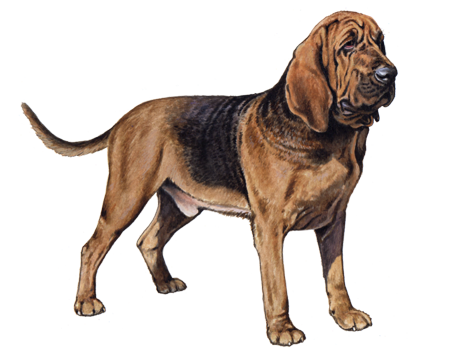
Plott Hound
American-bred, the Plott Hound is an active, alert, and intelligent dog. These loving dogs enjoy swimming and other activities, and although they do tend to have a stubborn streak, early and proper training can help them become the perfect pup.
Interested in discovering if your dog is a Plott Hound?
Check out Wisdom Panel's DNA tests.

Plott Hound Traits
General Appearance
This hunting hound is muscular and streamlined, with a long tail and flashy coat that comes in an array of brindle-stripe patterns. They also come in solid colors as well, such as black and a rare buckskin. They have droopy, medium-length ears and a confident face.
Coat and Coloring
The smooth, fine, and glossy Plott Hound coat is actually thick enough to offer protection against the elements when hunting. They are any shade of brindle, including yellow, buckskin, tan, brown, chocolate, liver, orange, red, light or dark gray, blue or Maltese, and black. They may also be solid black, or any shade of brindle with black saddle, and black with brindle trim. There is also a rare buckskin color ranging from red fawn or light cream to dark fawn or golden tan.
Distinctive Physical Traits
The Plott Hound has a fine and glossy coat that’s striking in appearance, and it comes in multiple shades of brindle.
Plott Hound Temperament
The Plott Hound is eager to please, but they also have a stubborn and independent streak that can make training difficult. They are loyal and alert when they’re with people, and bold and aggressive when hunting in the fields.


Plott Hound History
The Plott Hound is one of the few Coonhound breeds to originate in the United States without any English Foxhound ancestry.
In 1750, Johannes “George” Plott arrived in America with five Hanoverian Hounds. For seven generations, he and his descendants bred those dogs in the mountains of North Carolina. These dogs eventually carried the family Plott name and became famous as Coonhounds.
In 1989, the Plott Hound became the state dog of North Carolina.
Plott Hound Care
Nutrition
Feed your Plott Hound a high-quality dog food that’s suited to their particular age, activity level, and size, as well as any additional health concerns.
As with any dog, it’s important to monitor the amount of food and treats that you give your Plott Hound to avoid having them become overweight, especially as they age. Your veterinarian is always a good source to help provide you with appropriate nutrition and feeding guidelines.
Grooming
The Plott Hound’s striking fur requires minimal grooming to maintain its health and shine. Weekly brushing with a soft-bristle brush or grooming mitt will do the trick. A Plott’s floppy ears also require additional addition. Be sure to regularly inspect and clean their ears with a dog-specific ear cleaning solution.
All dogs require regular dental care, including at-home teeth brushing and professional dental cleanings, and the Plott Hound is no exception. Maintaining good dental hygiene is important for their overall long-term health.
Exercise
These tough hunters are an active and energetic breed and require plenty of vigorous daily exercise.
Since the Plott Hound aims to please and loves to hang with people, activities where you engage with your Plott—like play sessions in the yard—will be a favorite pastime for you both. Long walks or jogs are excellent exercise options, as well.
As with most hounds, the Plott has a strong instinct to hunt. Be sure to always keep this breed on a leash or in an enclosed area when outside.
Training
If left untrained, Plott Hounds may become aggressive over food or toys, and they can be standoffish and wary of strangers. When left to their own devices or not given enough attention, they may turn to undesirable hobbies. Early training is important, but also patience is essential since this breed can be stubborn.

Breed Group
Hound
The most common ancestral trait of this group is being used for hunting. Some use acute powers of scent to follow a trail while others demonstrate the gift of stamina as they run down a quarry. Beyond these two common traits, however, generalizations about hounds are hard to come by as the group is comprised of a very diverse lot of breeds.


































